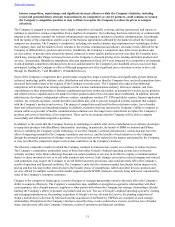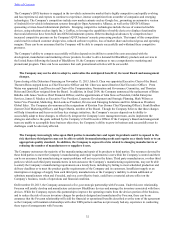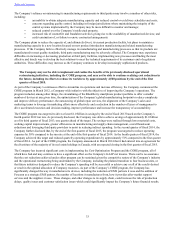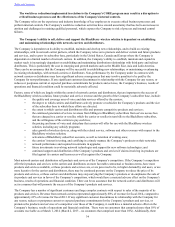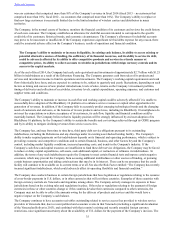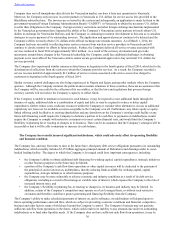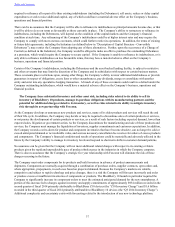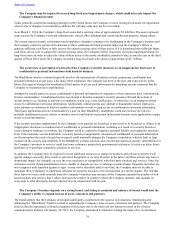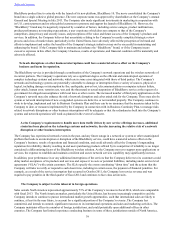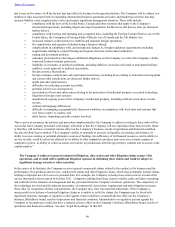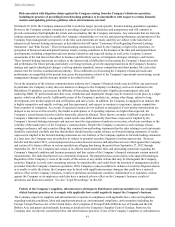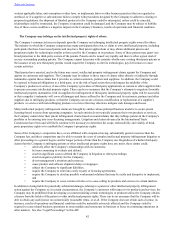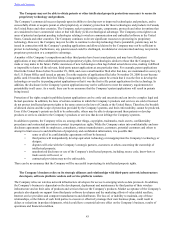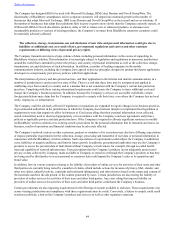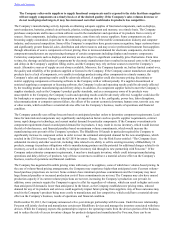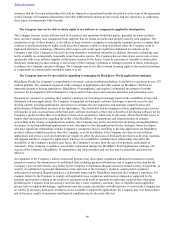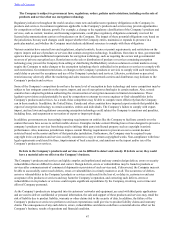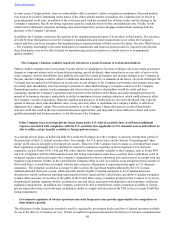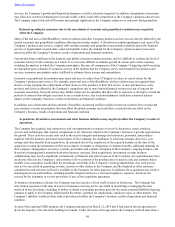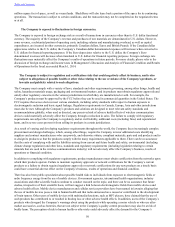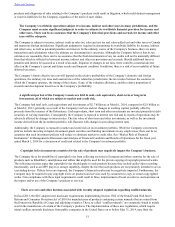Blackberry 2014 Annual Report Download - page 49
Download and view the complete annual report
Please find page 49 of the 2014 Blackberry annual report below. You can navigate through the pages in the report by either clicking on the pages listed below, or by using the keyword search tool below to find specific information within the annual report.
41
Risk associated with litigation claims against the Company arising from the Company’s disclosure practices,
including its practice of providing forward-looking guidance to its shareholders with respect to certain financial
metrics and updating previous guidance where circumstances warrant.
On March 29, 2012, the Company announced that it would no longer provide specific, forward-looking quantitative guidance.
However, the Company remains committed to providing a high level of disclosure and transparency and will continue to
provide commentary that highlights the trends and uncertainties that the Company anticipates. Any statements that are forward-
looking statements are intended to enable the Company’s shareholders to view the anticipated performance and prospects of the
Company from management’s perspective at the time such statements are made, and they are subject to the risks that are
inherent in all forward-looking statements, as described in this AIF under “Cautionary Note Regarding Forward-Looking
Statements” and “Risk Factors”. These forward-looking statements are made by the Company in light of its experience, its
perception of historical and anticipated business trends, existing conditions in the business at the time and anticipated future
developments, including competition and new product initiatives and expected timing, as well as the Company’s current
assessments of the risk factors that affect its business and the likely success of mitigation strategies relating to such factors.
These forward-looking statements are subject to the inherent risk of difficulties in forecasting the Company’s financial results
and performance for future periods, particularly over longer periods, given the ongoing transition in the Company's business
strategy and rapid technological changes, evolving industry standards, intense competition and short product life cycles that
characterize the wireless communications industry. These difficulties in forecasting the Company's financial results and
performance are magnified at the present time given the uncertainties related to the Company's operational restructuring, recent
management changes and the strategic initiatives described in this AIF.
Given the dynamics of the wireless communications industry, the Company’s financial results may not follow any past trends.
In particular, the Company’s entry into new markets or changes to the Company’s technology, such as its transition to the
BlackBerry 10 platform, can increase the difficulty of forecasting financial results. Significant unanticipated sales and
marketing, R&D, IT, professional and other costs, writedowns and impairment charges may be incurred or take place in a single
quarter, which can affect results. Additionally, many of the Company’s products are, among other things, subject to long
development, new product approval and certification, and sales cycles. In addition, the Company is engaged in an industry that
is highly competitive and rapidly evolving, and has experienced, and expects to continue to experience, intense competition
from a number of companies. As a result, if expected revenues are not realized as anticipated, if new product introductions are
delayed or are not as well received by the market as anticipated, or if operating expenses are higher than expected, the
Company’s actual financial results could be materially adversely affected. These factors can make it difficult to predict the
Company’s financial results. Consequently, actual results may differ materially from those expressed or implied by the
Company’s forward-looking statements and may not meet the expectations of analysts or investors, which can contribute to the
volatility of the market price of the Company’s common shares. Despite the Company’s cautions in each earnings release,
earnings conference call and securities filings that contains forward-looking statements that the risks relating to such statements
should be considered carefully and that shareholders should not place undue reliance on forward-looking statements, if results
expressed or implied in the forward-looking statements are not realized, or the Company updates its forward-looking statements
at a later time, the Company may nevertheless be subject to potential securities litigation or enforcement action. Between
October and December 2013, several purported class action lawsuits and one individual lawsuit were filed against the Company
and certain of its former officers in various jurisdictions alleging that during the period from September 27, 2012 through
September 20, 2013, the Company and certain of its officers made materially false and misleading statements regarding the
Company’s financial condition and business prospects and that certain of the Company’s financial statements contain material
misstatements. The individual lawsuit was voluntarily dismissed. The purported class action claims seek unspecified damages.
Regardless of the Company’s views of the merits of this action or any similar actions that may be filed against the Company,
securities litigation is costly, time-consuming and may be unpredictable, and could divert the attention of management and key
personnel from the Company’s business operations. If the Company is unsuccessful in its defense of securities litigation claims
or is unable to settle the claims, the Company may be faced with significant monetary damages that could have a material
adverse effect on the Company’s business, results of operations and financial condition. Administrative or regulatory actions
against the Company or its employees could also have a material adverse effect on the Company’s business, results of
operations and financial condition. See also “Legal Proceedings” in this AIF.
Failure of the Company’s suppliers, subcontractors, third-party distributors and representatives to use acceptable
ethical business practices or to comply with applicable laws could negatively impact the Company’s business.
The Company expects its suppliers and subcontractors to operate in compliance with applicable laws, rules and regulations
regarding working conditions, labor and employment practices, environmental compliance, anti-corruption (including the
Foreign Corrupt Practices Act of the United States, the Corruption of Foreign Public Officials Act of Canada and the UK
Bribery Act), and patent and trademark licensing as detailed in the Company’s Supplier Code of Conduct. However, the
Company does not directly control their labor and other business practices. If one of the Company’s suppliers or subcontractors
Table of Contents


